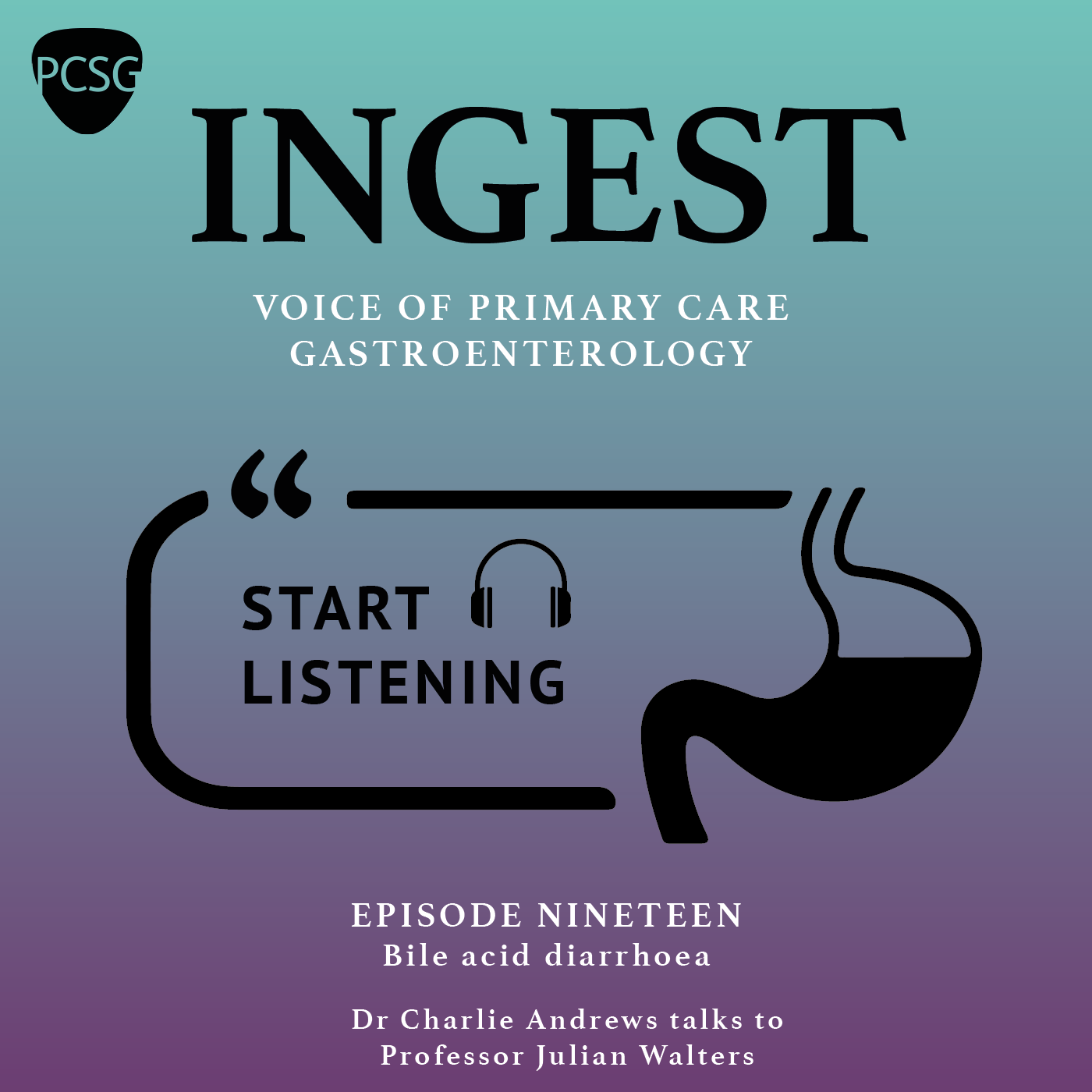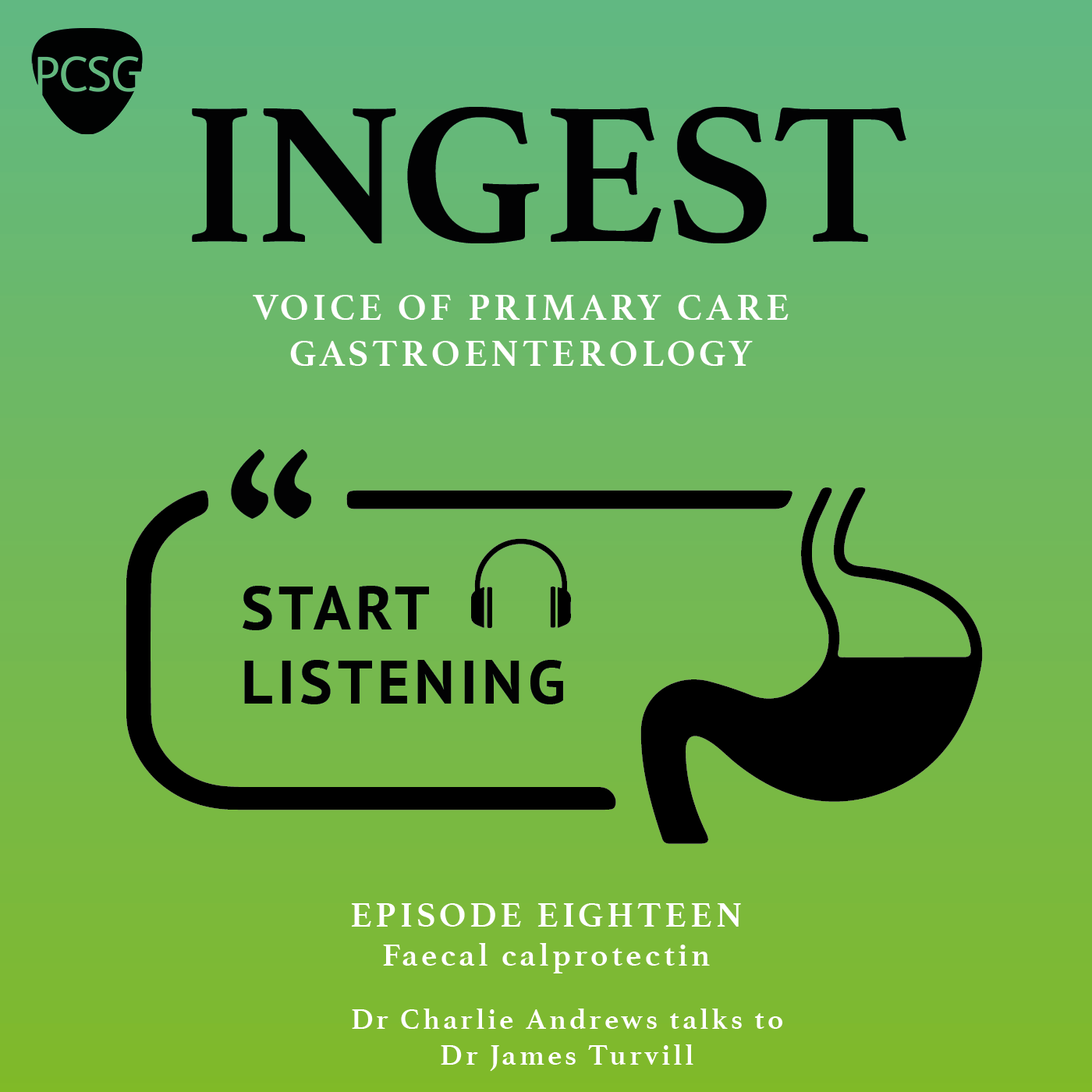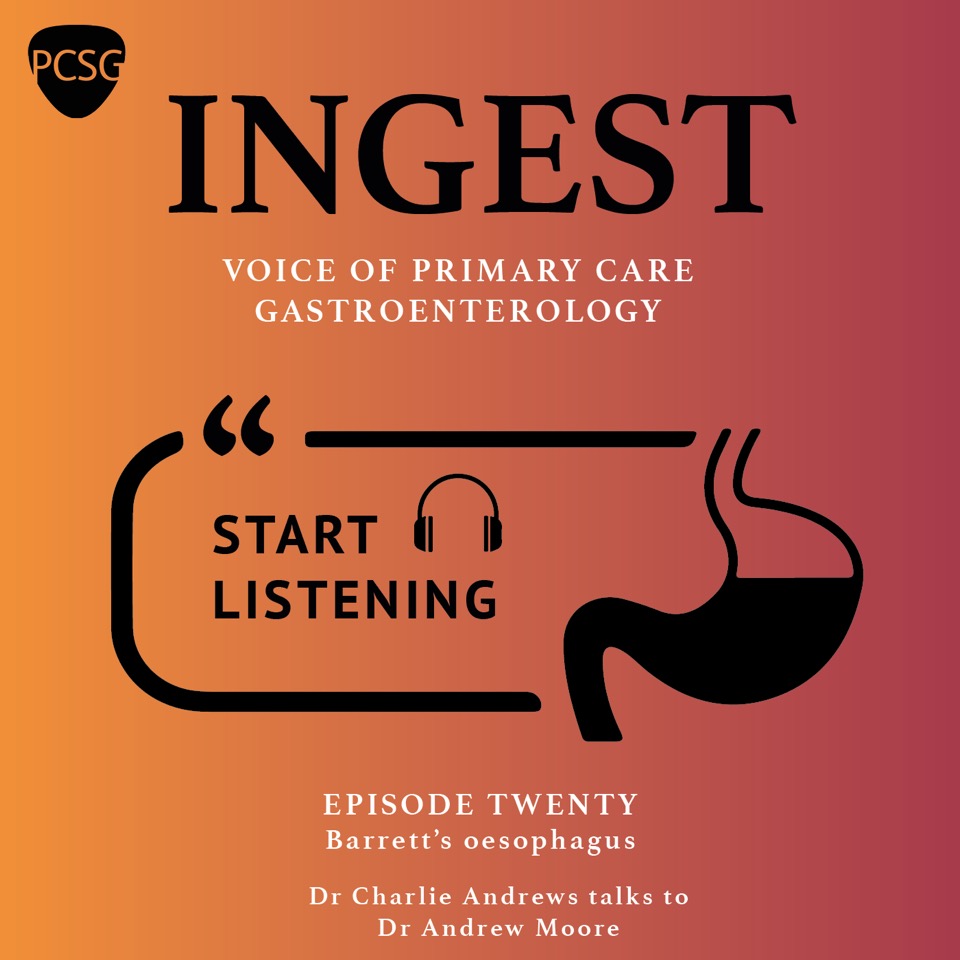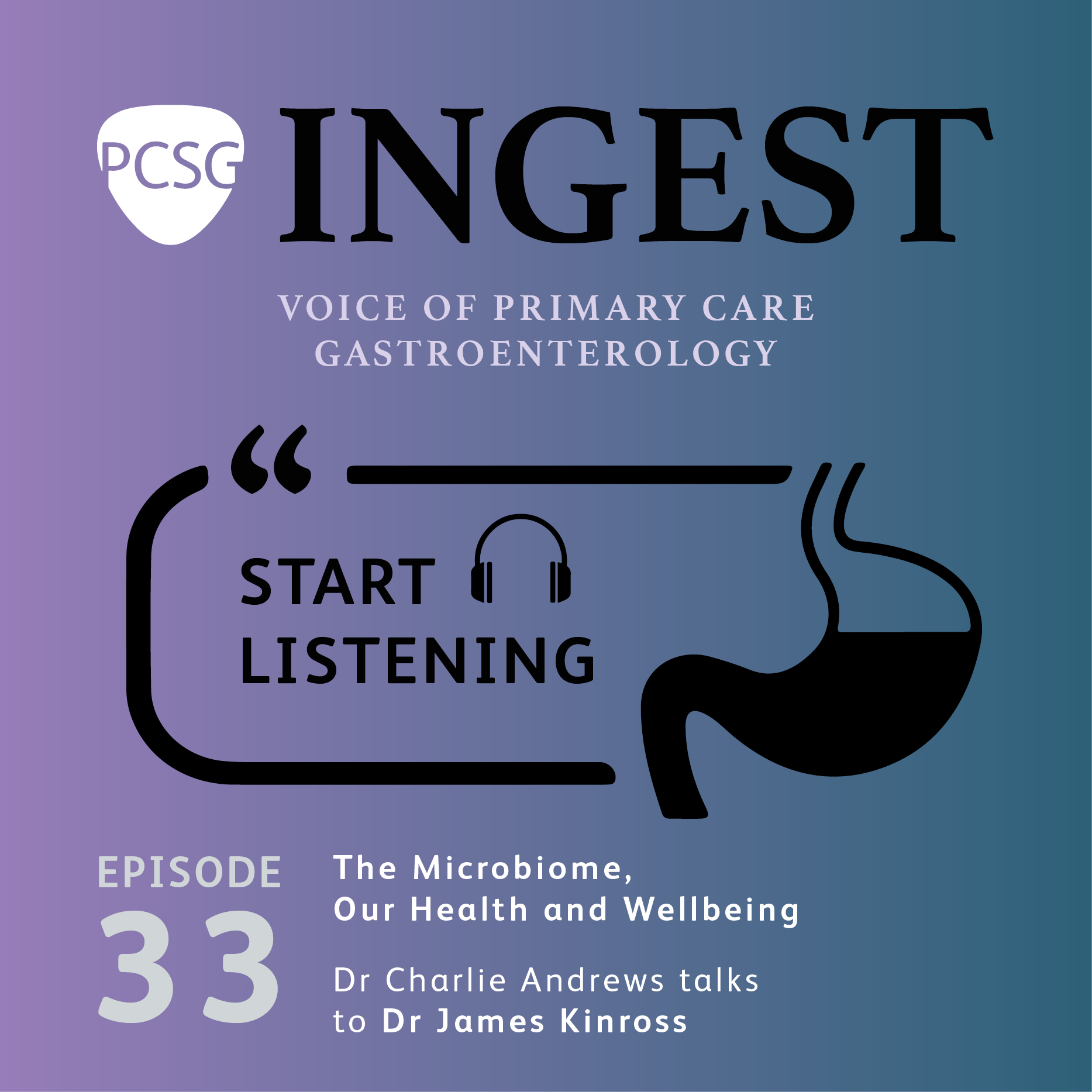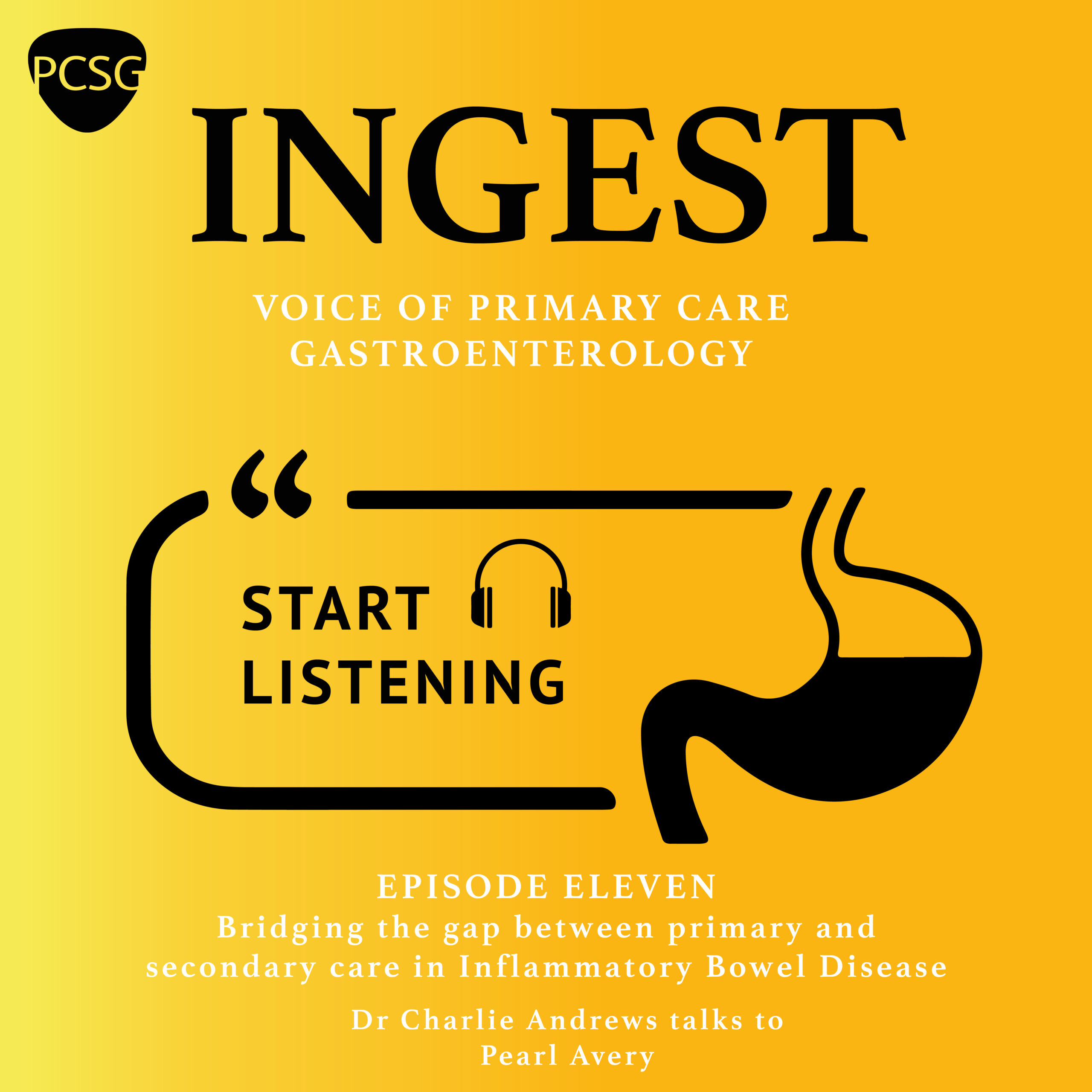Episode Transcript
[00:00:06] Speaker A: Welcome to ingest, the podcast series designed for primary care clinicians and brought to you by the Primary Care Society for Gastroenterology. My name is Charlie Andrews. I'm a GP and a GP with an extended role in gastroenterology based Near Bath. Ingest is an educational podcast. It is not designed to replace your clinical judgment or guidelines. However, it is there to try to provide you with more and up to date information about interesting and relevant topics for primary care.
In this episode, I'm talking about bile acid malabsorption and bile acid diarrhea with Professor Julian Walters. Professor Walters is a consultant gastroenterologist and professor at Imperial College London. He has a very strong research interest and has contributed a significant number of studies to our understanding of the clinical and basic functions of the small intestine, which includes the effects of diseases that cause malabsorption, such as celiac disease and Crohn's disease. He's also got a deep interest and understanding of bile acid diarrhea, and that is what we're going to be focusing on today.
So without further ado, welcome to the podcast, Julian.
[00:01:22] Speaker B: Thank you very much for asking me. I'm very pleased to be here to talk about bile acid diarrhea and bile acid malabsorption.
[00:01:29] Speaker A: Fantastic. Thank you. So, first off, what is bile acid malabsorption?
[00:01:34] Speaker B: So we know that bile acids are critical for the absorption of fats and lipids. So the liver makes bile acids, it secretes bile acids, they do their function to make the micelles within the small intestine help the absorption. But then the bile acids get reabsorbed in the terminal ileum and undergo an enterohepatic circulation.
So most bile acids will be reabsorbed. About 95% will be absorbed on each pass.
The bile acids that don't get absorbed go into the colon and then cause the problems that we associate with the diarrhea and the other symptoms of bile acid diarrhea. And you only need to reduce the amount of bile acids absorbed by 10 or 20%, so down to 70% each pass to get quite significant bile acid diarrhea.
[00:02:31] Speaker A: Thank you. That was a really helpful overview of bile acid malabsorption. Could we now talk a bit about the causes of bile acid malabsorption?
[00:02:39] Speaker B: It may be worthwhile mentioning that the classical grouping of bile acid related diarrhea is into three types, type one, which, which is the secondary causes due to ileal disease. So in patients who have Crohn's disease, the ileum doesn't work so, well, and there's malabsorption of bile acids there.
If patients with Crohn's disease have a terminal ileal resection, then there's bile acid malabsorption. If there is a resection for some other purpose, then again, bile acid malabsorption can result. Type 2 is the primary, so the primary cause will be confused with ibsd, which we can talk about a lot more. And then there's type 3, which includes the other causes that affect absorption. So there's cholecystectomy, but some of the other things like small intestinal bacterial overgrowth and radiation.
[00:03:43] Speaker A: Can I just ask about cholecystectomy and bile acid diarrhea? Is there a link between having the gallbladder removed and developing bile AC diarrhea?
[00:03:53] Speaker B: Post cholecystectomy, bile acid diarrhea is quite common. Perhaps 1 in 10 patients who have a cholecystectomy will suffer from that.
Now, exactly why that occurs isn't completely clear. The gallbladder obviously plays a major role in storing bile acids and then secreting them as a pulse at meal times. But it isn't clear why a certain proportion of people who have a cholecystectomy end up with this and others don't.
[00:04:26] Speaker A: Can I just ask, what are the primary causes that you're mentioning there?
[00:04:31] Speaker B: So primary bile acid diarrhea, idiopathic balanced malabsorption, as it was first called, has been known about for a long time, and it took a long time to appreciate that this was a type of ibs.
And we think that overproduction of bile acids is a major factor in the primary form of bile acid diarrhea.
[00:04:59] Speaker A: And what is there a proportion of patients with IBS D or IBS diarrhea predominant that potentially actually have bile acid malabsorption?
[00:05:10] Speaker B: Yeah. So, I mean, I think you need to think about it. In most patients, certainly those severe patients who have ibsd, and about a third of those can be shown on tests to have bile acid diarrhoea.
[00:05:28] Speaker A: That's a large proportion, isn't it?
[00:05:30] Speaker B: Yes, it is. If you work out the figures, about 10% of the general population have IBS. About a third of those have IBSD. And so if a third of those actually have primary bile acid diarrhea, then about 1% of the general population, so 1 in 100 people walking around will have primary bilacid diarrhea.
[00:05:58] Speaker A: Yeah, that's significant. That's definitely something to think about there for sure.
[00:06:01] Speaker B: Yeah. So it's similar. Similar to celiac disease, which we think about a lot and we screen for, it is more than patients with Crohn's disease. It's more than patients with ulcerative colitis. It's actually more than Crohn's and ulcerative colitis put together that come in at a 1% population prevalence.
And of course, there's masses of money spent on research for ibd.
Millions, tens of millions, hundreds of millions probably spent on drug development for ibd.
There is virtually none on primary bile acid diarrhea.
[00:06:43] Speaker A: Yeah. I'm going to talk a bit about making the diagnosis because there's clearly some challenges around how to actually make that diagnosis. So for a GP's perspective, sitting in primary care, we talked there about coeliac disease. There's a simple blood test that we can do, but for bile acid diarrhea, it's a bit more challenging. So I'm going to put that comment and that question on hold for the moment because I just want to dig in a little bit more to when we should be suspecting bile acid diarrhea. We talked about the IBS with diarrhea predominant symptoms. Are there other patient groups that we should be thinking about? How would someone present with bile acid diarrhoea?
[00:07:25] Speaker B: So the main thing that they have will be diarrhea, but it will be loose, watery stones, so usually type 6 or type 7 stones. So unformed or watery stones, they may be going anywhere between 4 and 12 times a day and at night, apart from being more severe, it is difficult to define the group that actually have bile acid diarrhea, but I get to see people who've been going six to eight times a day for 20 years. They've had various colonoscopies, they've had various tests done, but nobody has thought that might be bile acid diarrhea. Patients report that there's very poor understanding in primary care and indeed in secondary care and in health service in general to accept that this might be a disease that can be treated.
[00:08:30] Speaker A: In your experience, do you find that there's quite a long delay from initial presentation of these patients to when they're being diagnosed?
[00:08:37] Speaker B: Yes.
[00:08:38] Speaker A: Yes.
[00:08:38] Speaker B: Our patients did a survey and almost half of them had waited over five years with these symptoms before they were diagnosed.
[00:08:47] Speaker A: It's a long time, isn't it?
It's a challenging condition because it does look like a number of other conditions. And as gps, we are primed to look for inflammatory bowel disease, celiac disease, bowel cancers, etc. Perhaps less so to look for bile Acid malabsorption. But one of the big challenges is that we don't have a simple diagnostic tool in the community that we can use to make that diagnosis. And we know that waiting times within secondary care to access, you know, diagnostic tests for this condition can be quite long. Could you talk a bit about how the diagnosis is made?
[00:09:29] Speaker B: So the first thing that we must do is think about it. So once people have thought about it, the way we diagnose these people in Britain is we're fortunate to have the CCAT test. That's the selenium homocholic acid taurine test.
Not all countries have this and because they don't have it in the us, it means that the recognition of the disease is even worse in the USA than it is here.
Fortunately, most of our district general hospitals have or have good access to nuclear medicine. Gamma scans, which is the usual way that the CCAP test has been done. It is actually a very simple test. You don't get the imaging, you just get the quantification of the amount of the bile acid which is left. So patients take a, a capsule that contains ccad. So this is a gamma labeled selenium. The radiation is actually quite low. The total body exposure works out as being about the same as a plain abdominal X ray or perhaps a transatlantic flight in terms of radiation. So it's minor certainly compared with CTS or PET scans or some of those other other things that are done.
Patients take the CCAP capsule on day zero, they have their scan, then they go away, they have a normal week and come back on day seven to have a second scan. And the proportion of the radioactivity that is left at a week is the CCAP retention value. So the normal figures are usually more than 20% of CCAT remains. We diagnose malacid malabsorption and excess loss of bile acids with a figure less than 15%. 15 to 20 we say is borderline and you can be diagnosed with severe with a CCAT of 1 or 2 or 3%, less than 5, moderate disease between 5 and 10 and mild disease between 10 and 15.
And this scan is very, very predictive of a in response to drug therapy.
[00:11:58] Speaker A: That's really helpful. And I was going to ask about the role of empirical treatment in primary care. Is there a role for trial of treatment in patients where you've done, as you said, you've done the hard work and you've actually thought about bile acid diarrhea and you would like to then trial a treatment to see if that can confirm your Diagnosis or help support your diagnosis. Where do you sit with empirical trials of treatment?
[00:12:22] Speaker B: With this, I think it's important to say that we need to be sure that we've excluded the other things that you mentioned, the celiac disease, the cancers, the inflammatory bowel disease. So negative fucal card protectants are important, negative celiac serology.
And depending upon the age, perhaps fit testing or consideration for colonoscopy is important. But if somebody is 25 and they've had that diarrhea for six years and you know, they've had faecal car protectants and CRPs and things done, and that's all fine, then it needs to be thought about.
If you thought that patient had celiac disease, you probably wouldn't go on to a gluten free diet without at least getting some diagnostic help. And we are fortunate we've got celiac serology to support that. But even there, we still want to get a duodenal biopsy because it's a lifelong disease that needs certain treatments and changes. So I strongly prefer to get a positive diagnosis for bile acid diarrhea with a CCAP test.
Having said that, if a patient's pregnant, if it isn't easy to get a CCAP test, then it may be tempting to do a trial of bile acid sequestrance. But bio acid sequestrance can be difficult to take, it can be difficult to get the dosing right. It helps a great deal to know the disease extent. So a patient with a CCAP test of 14 is much less likely to respond than a patient with a CCAP test of 1. If a patient has a CCAP test of 1, you just have to find the right dose and that may be sort of increasing medication. It may be changing the timing or some other factors need to be taken in into account.
[00:14:16] Speaker A: Brilliant, thank you, that's really helpful. So really we want to try to make that firm diagnosis because it will help with compliance with the medication and we are considering this a sort of a longer term treatment. But this brings me on to the final part of this, which is really about how we treat bile acid diarrhea. Could you talk about some of the treatments you've mentioned there, the bile acid sequestrations? Could you talk a bit more about those, how they're taken, perhaps some of the side effects of these as well?
[00:14:44] Speaker B: Yeah. So balance it to Crestrance. You've got cholestyramine, which has been around for a long time, over 50 years. So that's been known as Crestran, although it's now generic and it Comes in either the original sugar containing forms or the light form which contains aspartame. And we won't go into that any further at the moment, but I've had a few patients talking to me about that. So, acolythylamine is a powder. It comes as a 4 gram sachet.
Some people don't like the taste, some people don't like the texture, but they can usually get used to that, finding the amount of water to take it with.
Sometimes people take it with other juices.
So my starting dose would be a single 4 gram sachet of colysylamine, but I would give it last thing at night. Now, the packaging suggests that you should take it with meals because cholestylamine was originally produced to bind bile acids, which would then drive the conversion of cholesterol to bile acids and so would lower cholesterol within the blood. And so you wanted to bind the bile acids quickly and easily in order to promote the cholesterol conversion.
What we want to do is we want to get the bio acid sequestrant into the colon to bind the leftover bile acid. So you really don't need to bind those in the duodenum because the bulk of them will be absorbed if there's overproduction. You just want to be able to reduce the amount of free bile acids within the colon. So patients report, and this is a fairly consistent finding, that it works better taken on an empty stomach. But last thing at night, cholestylamine is one. Cholestopol has been around, but cholestopol isn't being produced at the moment. And so that may be difficult to carry on with.
There's Colicevolan, which comes as a tablet. It's a fairly big tablet, but patients often prefer to take the big tablet over the powder.
It's a slightly better bile acid binder, but of course we want to be sure that it can get down to the colon to do its binding there. We don't want to bind it and fill it up with bile acids too soon. So a starting dose in a typical size patient would be two of the six to five milligram tablets of colosavalam.
There's been a good study that has been published in the Lancet, Gastroenterology and Hepatology within the last year, looking at colocevalam against placebo. Surprisingly, there had been no satisfactory placebo controlled trials of bile acid sequestrants before that. But this was a very clear one. Patients who had had a CCAT test had and had a CCAP test, less than 10% had a tenfold greater response to colacevolam within two weeks as compared to placebo.
So very clear benefit there.
Okay. The diarrhea improved, the urgency improved, and there was some improvement in quality of life that could be shown even at this point.
So Codecivalan is good, it's slightly more expensive, but it's a more powerful binder and comes out as a tablet.
[00:18:42] Speaker A: That's brilliant. That sounds. I'm sure that will have a huge impact on quality of life because having experienced and seen patients with this condition, it can be very debilitating in terms of side effects of the treatment. Are there any important side effects that patients report or that we should be aware of?
[00:19:00] Speaker B: The most important side effect is that the bile acid sequestrants combined other medications. So other medication needs to be taken at least one hour before or four hours afterwards. This could be important if a patient is taking coerce with oral contraceptive pill at night.
You would not want the medication to bind to the Colacevalan and then be ineffective. Other medication like thyroid hormones or hypertensive medicine and in fact anything taken by mouth needs to be taken at least an hour before. Sometimes patients need multiple doses. And if they're taking Konosambalan twice a day or three times a day, or indeed Konisaramine, it often helps to have the other dose between breakfast and lunch and between lunch and dinner. So at 11:00 or 4:00. But again, keeping in mind that the medication needs to be taken at least an hour before or four hours afterwards.
[00:20:08] Speaker A: That's really helpful and really obviously really important to bear in mind when we're prescribing. Is treatment long term? Is it lifelong? I'm asking here a little bit around prognosis of bile acid diarrhea. Do we know what the long term outlook for these patients is, particularly those with primary causes of bile acid diarrhea?
[00:20:28] Speaker B: When people have looked at CCAP tests, they hardly change over five or 10 years. I've had patients who've had this condition for 20 or 30 years and have been treated and have stayed on treatment the whole time.
Patients often find that if they miss the medication for a day or two, their symptoms come back straight away.
So I think we have to prepare patients that this is going to be a long term treatment that will not get worse. It may get a bit better, they may get more tolerant of things.
We haven't talked about the effects of diet. So some patients find that by reducing the amount of fat in in the diet, they can reduce the amount of bile acids produced and this then means that perhaps they can tolerate a bowel habit of four times a day rather than six times a day. So it is important to look at this.
I say to patients that if their symptoms vary from day to day, so that if they're going to two or three times most days and then have one day a week when they go six, six times, it is probably going to be dietary related. So they need to look at what the food was they had in the 24 hours before they went multiple times. And that's often fats. But you have to think about other foodstuffs that can also cause that diarrhea. And so the knowledge of FODMAPs becomes important then.
[00:22:09] Speaker A: Brilliant. Thank you. So we're coming to the end now, Julian, and this is your opportunity to draw out your key messages for our listeners. So do you have any key take homes that you'd like our GPs and primary care clinicians to take away from this episode?
[00:22:27] Speaker B: The most important thing is to think about could it be primary acid diarrhea or indeed post cholecystectomy or post radiation bile acid diarrhea?
Many patients are concerned when they get these symptoms that something else is going on and it's natural to want to investigate patients for these. It's important to be sure that the serious things have been excluded. But you need to be aware how common bile acid diarrhea is and how it's much more likely to go up after cholecystectomy or surgery.
Do not let patients suffer from severe functional diarrhea. IBSD if they're going six times a day. If they have urgency, they can often have fecal incontinence.
They may have quite major mental and social problems because of the urgency that goes there. Do find the drugs that help.
Obviously loperamide can help, but if that isn't satisfactory, think about bile acid diarrhea. Think about whether they need to have a test and whether they ought to go onto a bile acid sequestrant.
Hopefully as time goes on we'll be able to find a simple test, a parallel along with the celiac disease serology that maybe be able to screen a patient who needs that. And there are some tests in the pipeline, but currently the diagnosis is by CCAP testing.
[00:24:19] Speaker A: Brilliant. Thank you so much. That's been a really interesting discussion about bile acid diarrhea. I've learned huge amounts from you, so thank you very much. I'm sure that our listeners will have found that interesting. As well. It's a really important topic and it's one that perhaps we don't always feel hugely confident about, but hopefully our listeners now will have greater confidence to go out there and really think about it in those patients with particularly with really difficult ibs. And we'll go out there and find those patients and treat them and start to make them feel better. So thank you so much for joining me.
[00:24:55] Speaker B: Julian well, thank you very much for asking me and if people want to email me and ask any further questions, you can find my email online.
[00:25:06] Speaker A: So thank you so much for joining me today and spending your time learning with ingest. I'd also like to say a huge thank you to Professor Walters, who's given his time to talk to us today. He really is a fountain of knowledge around bile acid diarrhea and I've certainly learned a huge amount from him. I just wanted to share a couple of take home messages that I've certainly taken from this episode and learning points that I'm going to go away with after talking to Professor Walters. So firstly, I was surprised by how common this condition is. I wasn't really aware that up to 1% of the population has bile acid diarrhea. And when we were talking about patients with IBS diarrhea predominant symptoms, he mentioned that up to a third of patients may well have bile acid diarrhea, which is a huge number. So this is really making me think about those patients who've got really difficult IBS symptoms.
My second take home was around cholecystectomy. So thinking about that link between cholecystectomy and bile acid diarrhea and keeping it on the horizon for patients who have diarrhea symptoms after gallbladder removal. My final take home was around the medications. So he mentioned that it was important that bile acid sequestrants are taken at night to make sure that they're as effective as possible, and also that we make sure that other medications are taken an hour before or four hours after bile acid sequestrants to make sure that the bile acid sequestrant, that is the colocevolam or the cholesterol, does not impact the absorption of other medications that the patient's taking, particularly around things like thyroxin, which you mentioned, and oral contraceptive medication.
So thank you so much for joining me. It's always really helpful to have any feedback, so if you want to leave a review or send any feedback to us, that would be fantastic. I'm always trying to improve the podcast, make it as beneficial to you as possible, so please don't hesitate to get in touch with us and give us some feedback if you've enjoyed this episode. We have plenty more within the podcast that you can listen to, and if you click follow then you will get a notification every time we bring out a new episode, which we're aiming to do every month. Thank you very much for joining me today.
